Back Exercises
By Lee Hayward

|
Make Sure To Sign Up For My FREE Bodybuilding & Fitness Tips Newsletter!
Just type in your name and primary e-mail address below and you'll
be immediately enrolled to receive my information packed newsletter.
|
Back Muscle Anatomy
There are three primary muscles groups in the back - the trapezius muscles in the upper back, the latissimus dorsi muscles in the mid-back, and the erector spinae muscles in the lower back.
There are several other smaller muscles in the back, all of which will be developed by performing exercises that work the three main back muscles.
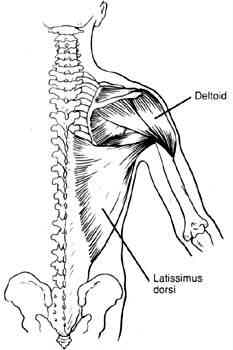
The trapezius (also known as the "traps") is a large, kite shaped muscle with the top point at the base of the skull, the two side points near the shoulder joints, and the lower point roughly halfway down the spinal column. Many people consider the traps to be a shoulder muscle, but it is actually the largest muscle group in the upper back.
(I have an article on training the traps at: http://www.leehayward.com/art27.htm).
The latissimus dorsi (also known as the "lats"), lie across the middle section of the back on each side. This muscle group when well developed gives the upper body that V shape. The lats originates from attachments along the spine and inserts with a large tendon to the humerus (upper arm bone) on each side of the body.
The erector spinae muscles of the lower back are like two thick columns of muscle on either side of your spinal column. The spinal erectors run from the base of your pelvis to almost the full length of your spine. However, they are most easily visible from the middle to the lower back.
Back Exercises
It is essential that when you do any exercise that you perform the movements correctly, if you don't you will receive less then optimum benefit from the exercise. It is very difficult to unlearn bad exercise habits, so it is best to learn the right exercise technique from the very start.
Tip - You can fully contract the lats only when you arch your back. When training your lats, arch your back in the fully contracted position of each lat exercise to maximize the peach contraction and get full lat development.
For each back workout pick 3 of these exercises and do 4 sets for each exercise. You can vary the exercises you do for each back workout.
Deadlifts
This is one of the best power building exercises that you can do. Deadlifts work the spinal erectors, quadriceps, buttocks, hips, forearms, trapezius, lats, and abdominals.

Stand in front of a barbell with your shins very close to the bar. Feet shoulder width apart. Grab the bar with your hands slightly wider then shoulder width. Keeping your arms straight, bend your legs and flatten your back. Position yourself so it is like you are doing a squat with the barbell at arms length in front of you.
Slowly pull the barbell off the floor by straightening your legs and torso until your body is completely erect. Pull your shoulders back. Then slowly lower the bar back to the starting point. Repeat. Do not let the barbell touch the floor in between each rep. Keep the tension on the muscles during the entire exercise.
Tip - if you have trouble griping the bar when using heavy weights, you can use a reversed grip in which one hand the palm is facing forward and with the other hand the palm is facing backward. This will enable you to grip heavier weights. Another option is to use a pair of lifting straps and strap your hands to the barbell as is shown in the picture below.

Hyperextensions
This exercise is great for working the spinal erectors, buttock, and hamstrings.
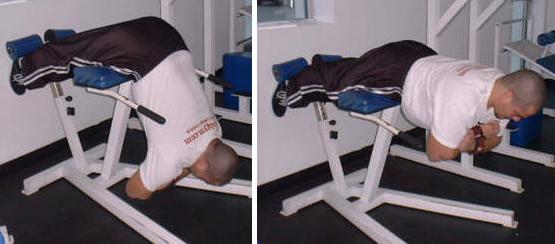
Stand in the middle of the hyperextension station. Facing toward the large flat pad, lean forward until your upper thighs are placed on the pad. With your legs straight place your feet under the smaller pad.
When in position, slowly lower your upper body at the waist until it is perpendicular to the floor. Then slowly lift your upper body back to the starting position. At the top of the movement arch your back and hold this position for a second to maximize the peak contraction. Repeat.
Tips - if you do not have access to a hyperextension station you can use a high table or high exercise bench and have a training partner restrain your legs. If you want to add resistance to the exercise you can hold a weight plate to your chest.
Bent Barbell Rows
This is a basic back exercise that works the latissimus dorsi, trapezius, erector spinae, biceps, and the forearms.

Bend over at the waist and grab a barbell with your hands placed shoulder width apart. Keep a slight bend in the knees. Lift the bar with your arms straight. Keep your upper body at a 45-degree angle to the floor and arch your back.
Moving just your arms row the barbell into your stomach. Hold this position and squeeze your back muscles for a second to maximize the peak contraction. Slowly lower the bar until your arms are straight, but do not let the barbell touch the floor in between each rep. Keep the tension on the muscles. Repeat.
Tips - For variety you can use an underhand grip (i.e. palms of the hands facing forward) this will work the lower lats more. You can also do this exercise with dumbbells or a low cable pulley.
1 Arm Dumbbell Row
This exercise works the latissimus dorsi, trapezius, biceps, and the forearms.
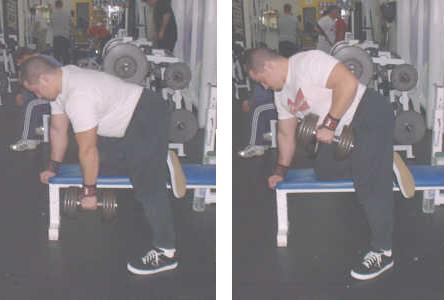
Kneel on a flat exercise bench with one knee, you other foot placed on the floor beside the bench. Support your upper body by placing your hand on the end of the bench. With your other hand grab a dumbbell. Keep your back flat and let the dumbbell hang down at arms length.
Keeping your elbow close to your side, slowly pull the dumbbell directly upwards until it touches the side of your torso. Squeeze your back muscles for a second to maximize the peak contraction. Slowly lower the dumbbell back to the starting position. Repeat for the desired number of reps. Do the same for your other arm.
T-Bar Rows
This exercise works the lats, spinal erectors, traps, rear deltoids, biceps, and forearms.

Stand with your legs on each side of the T-bar. Grab the handle with both hands. Slightly bend your knees to take the stress off the lower back. Keep your upper body at a 45-degree angle with the floor. Let your arms hang down in front.
Use your lats and arm strength to pull the T-bar up and row it into your abdomen. Arch your back and squeeze your lats together to maximize the peak contraction in the back muscles. Slowly lower the T-bar back to the starting position. Repeat.
Tip - for variety you can do this exercise with a reverse grip to hit the back muscles from a different angle.
Seated Pulley Rows
This exercise is good for working the latissimus dorsi, spinal erectors, trapezius, biceps, and forearms.
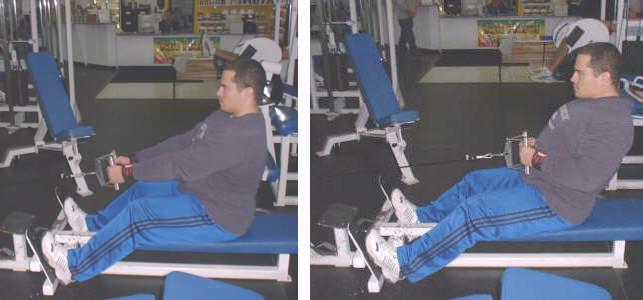
Attach a narrow handle to a low cable pulley. Sit in front of the machine and grab the handle with both hands. Brace your feet and keep your knees slightly bent.
Lean forward and straighten your arms to stretch your lats completely. Hold this stretched position for a second. Then pull the handle into your stomach and sit up straight. Arch your back and squeeze your back muscles, hold this position for a second to maximize the peak contraction. Repeat.
Tip - you can use different handles and grips to work the back muscles from different angles. (i.e. overhand grip, underhand grip, etc.)
Lat Pulldowns
The lat pulldown works the lats, rear deltoids, biceps, and forearms.
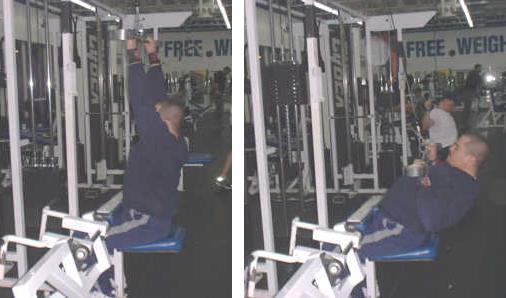
Attach a straight bar to a high pulley. Grab the bar a bit wider then shoulder width. Sit or kneel in front of the pull down machine.
Straighten your arms and let your lats stretch. Hold this position for a second. Arch your back slightly and pull the bar down in front of your head until the bar is just below your chin. Hold this position for a second to maximize the peak contraction. Slowly straighten your arms to the starting position. Repeat.
Tips - you can vary your grip to work your back from different angles. (i.e. wide grip, narrow grip, overhand, underhand, etc.)
Chin Ups
The chin up works that same muscles as the lat pulldown (i.e. the lats, rear deltoids, biceps, and forearms). Chin ups are an advanced exercise because you have to be able to lift your entire bodyweight.
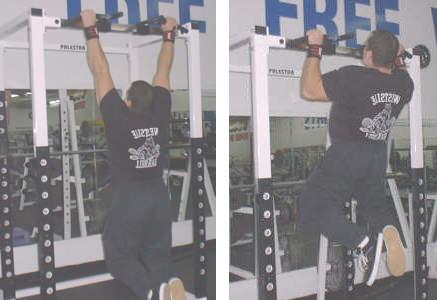
Grab a chin up bar with your hands a bit wider then shoulder width apart. Bend your legs so that your body is hanging from the chin up bar.
Straighten your arms and let your lats stretch. Hold this position for a second. Arch your back slightly and pull yourself up to the bar until your chin is just over the bar. Hold this position for a second to maximize the peak contraction. Slowly lower yourself to the starting position. Repeat.
Tips - you can vary your grip to work your back from different angles. (i.e. wide grip, narrow grip, overhand, underhand, etc.). If you have trouble gripping the bar you can use a pair of lifting straps and strap your hands to the chin up bar.
Good Mornings
This exercise works the spinal erectors, buttocks, and hamstrings.
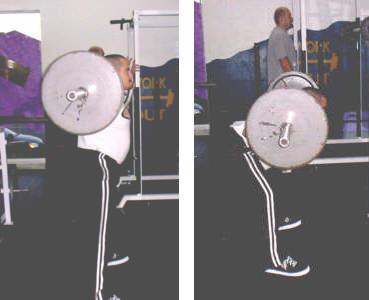
Use a rack such as a squat or power rack to hold the barbell. Place your feet shoulder width apart under the bar. Grasp the bar just wider then shoulder width, duck your head under the bar and position it on your trapezius muscles behind your neck. Lift the bar from the rack and take a few steps back. Position your feet shoulder width apart with your toes pointed just slightly out to the sides. Look forward and keep your head up.
Keep a slight bend in the knees and slowly lower your upper body until it is a little lower then a 45-degree angle with the floor. Then slowly lift your upper body back up to the starting position. Repeat.
Tip - use very light weights when starting out with this exercise and build up gradually, because it places a lot of
stress on the lower back.
Pull Through
This exercise works the spinal erectors, buttocks, and hamstrings.
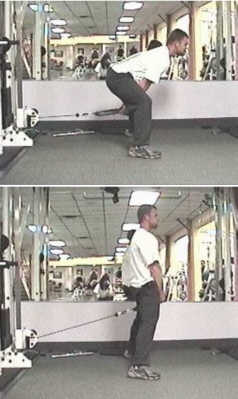
Using a low pulley cable, stand facing away from the machine with the cable between your legs using a medium, stance. Begin by letting the cable pull your arms through your legs, then flex back to the starting position making
sure to squeeze your glutes as you rise.
Back Extension Using The Stability Ball
This exercise works the entire back area, but because you have to balance yourself on the ball it focuses on developing the small stabilizer muscles.
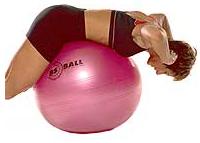
Lie face down on a stability ball. Position yourself so that you are balanced directly over the ball. When you are balanced slowly extend your arms and legs so that you are balancing your entire body on the ball. Hold this position in a static rep for as long as you can.
This exercise will take some practice because it requires a lot of balance and coordination in your stabilizer muscles. Overtime you will be able to hold your balance on the ball for a longer period of time. This is a great finishing exercise to do at the end of your back workout.
Click Here to go
back to the Bodybuilding and Fitness Articles.
| 
